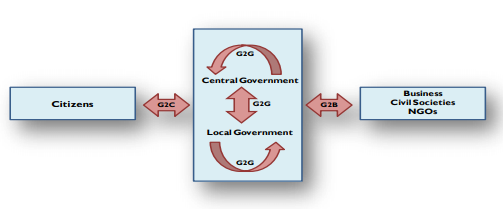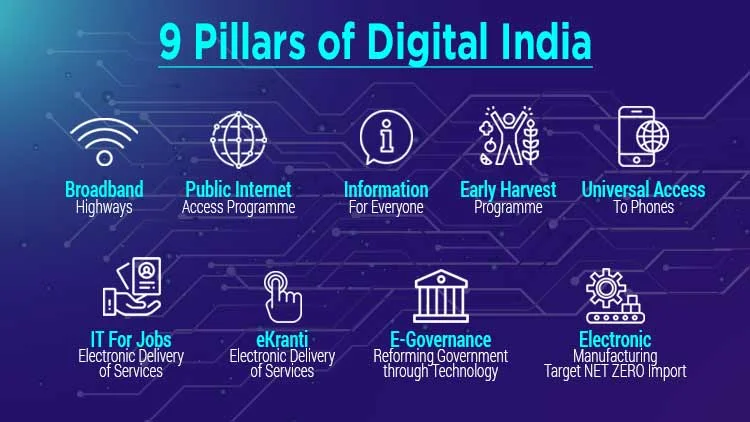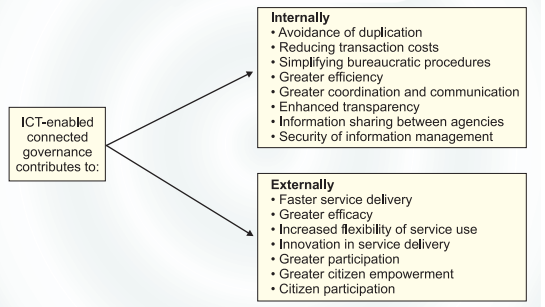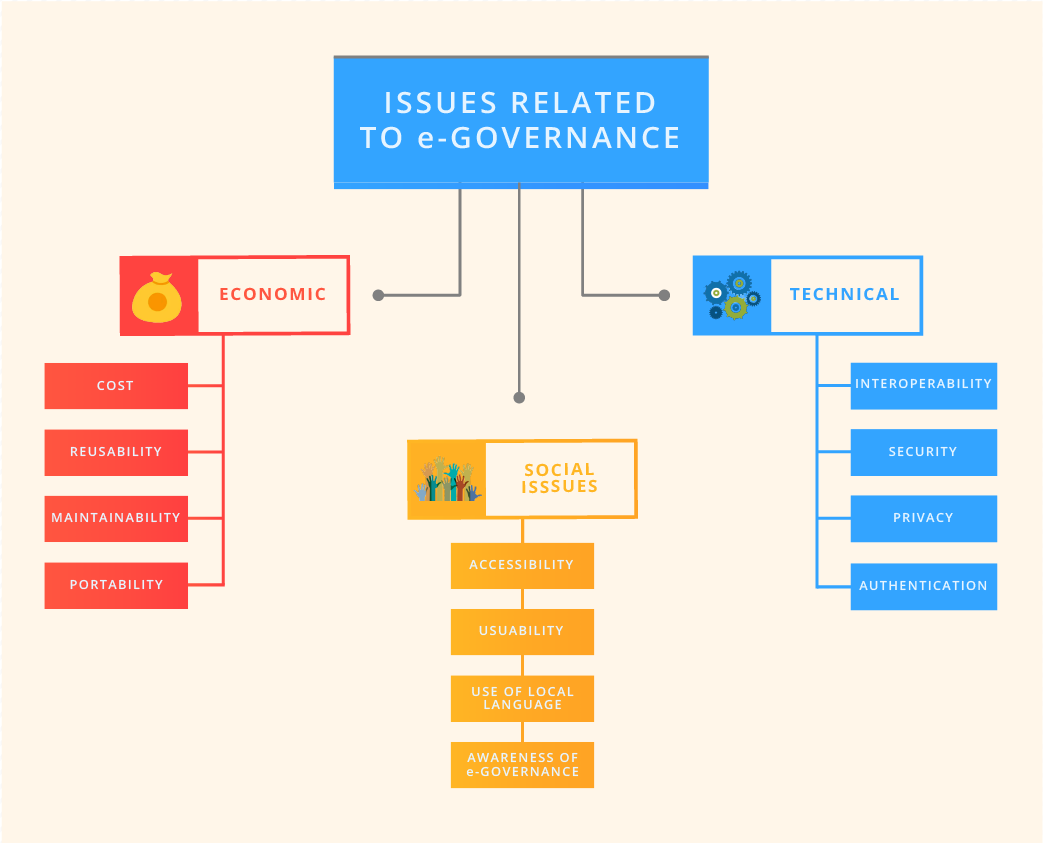Governance
e-Governance
- 17 Oct 2019
- 16 min read
- e-Governance can be defined as the application of information and communication technology (ICT) for providing government services, exchange of information, transactions, integration of previously existing services and information portals.
- The “e” in e-Governance stands for ‘electronic’.
The Council of Europe referred to e-Governance as:
- The use of electronic technologies in three areas of public action:
- relations between the public authorities and civil society
- the functioning of the public authorities at all stages of the democratic process (electronic democracy)
- the provision of public services (electronic public services)
Reasons for Opting e-Governance
- Governance per se has become very complex
- Increase in citizens’ expectations from the government
Different Connotations of e-Governance
- e-Administration: The use of ICTs to modernize the state; the creation of data repositories for Management Information System (MIS) and computerization of records (land, health etc).
- e-Services: The emphasis here is to bring the state closer to the citizens.
- For Examples: Provision of online services.
- e-administration and e-services together constitute what is largely termed as e-government.
- e-Governance: The use of IT to improve the ability of the government to address the needs of society.
- It includes the publishing of policy and program-related information to transact with citizens.
- It extends beyond the provision of online services and covers the use of IT for strategic planning and reaching the development goals of the government.
- e-Democracy: The use of IT to facilitate the ability of all sections of society to participate in the governance of the state.
- Emphasis is on bringing transparency, accountability, and participation of people.
- It includes online disclosures of policies, online grievance redressal, e-referendums etc.
Origin
- e-Governance originated in India during the 1970s with a focus on in-house government applications in the areas of defence, economic monitoring, planning and deployment of ICT to manage data intensive functions related to elections, census, tax administration etc.
Initial Steps Taken
- The establishment of the Department of Electronics in 1970 was the first major step towards e-governance in India as it brought ‘information’ and its communication to focus.
- National Informatics Centre (NIC) established in 1977, launched the District Information System program to computerize all district offices in the country
- The main thrust for e-governance was provided by the launching of NICNET in 1987 – the national satellite-based computer network.
Objectives
- Better service delivery to citizens.
- Ushering in transparency and accountability.
- Empowering people through information.
- Improve efficiency within Government i.e between centre-state or inter-states.
- Improve interface with business and industry.
Pillars of e-Governance
- People
- Process
- Technology
- Resources
Types of Interaction in e-Governance
- G2G i.e. Government to Government
- G2C i.e. Government to Citizen
- G2B i.e. Government to Business
- G2E i.e. Government to Employees
Initiatives Taken for e-Governance in India
| S.No. | Program | Details |
| 1. | Bhoomi Project (Karnataka): Online Delivery of Land Records | Bhoomi is a self-sustainable e-Governance project for the computerized delivery of 20 million rural land records to 6.7 million farmers of Karnataka. |
| 2. | KHAJANE (Karnataka): End-to-end automation of Government Treasury System |
|
| 3. | e-Seva (Andhra Pradesh) |
|
| 4. | e-Courts |
|
| 5. | e-District |
|
| 6. | MCA21 |
|
| 7. | e-Office |
|
Digital India Initiatives
- It is an umbrella program to prepare India for a knowledge-based transformation.
- It weaves together a large number of ideas and thoughts into a single comprehensive vision so that each of them is seen as part of a larger goal.
- It has been launched by the Ministry of Electronics and Information Technology (Meity).
Vision Areas
- Digital infrastructure as Utility to Every Citizen
- Governance and services on demand
- Digital empowerment of citizens
Various Initiatives Under Digital India Initiatives
- MyGov: It aims to establish a link between Government and Citizens towards meeting the goal of good governance.
- It encourages citizens as well as people abroad to participate in various activities i.e. 'Do', 'Discuss', 'Poll', 'Talk', ‘Blog’, etc.
- DigiLocker: It serves as a platform to enable citizens to securely store and share their documents with service providers who can directly access them electronically.
- e-Hospital-Online Registration Framework (ORF): It is an initiative to facilitate the patients to take online OPD appointments with government hospitals. This framework also covers patient care, laboratory services and medical record management.
- National Scholarships Portal (NSP): It provides a centralized platform for application and disbursement of scholarship to students under any scholarship scheme.
- DARPAN: It is an online tool that can be used to monitor and analyze the implementation of critical and high priority projects of the State.
- It facilitates presentation of real time data on Key Performance Indicators (KPIs) of selected schemes/projects to the senior functionaries of the State Government as well as district administration.
- PRAGATI (Pro-Active Governance And Timely Implementation): It has been aimed at starting a culture of Pro-Active Governance and Timely Implementation.
- It is also a robust system for bringing e-transparency and e-accountability with real-time presence and exchange among the key stakeholders.
- It was launched in 2015.
- Common Services Centres 2.0 (CSC 2.0): It is being implemented to develop and provide support to the use of information technology in rural areas of the country.
- The CSCs are Information and Communication Technology (ICT) enabled kiosks with broadband connectivity to provide various Governments, private and social services at the doorstep of the citizen.
- Mobile Seva: It provides government services to the people through mobile phones and tablets.
- Jeevan Pramaan: It is an Aadhaar based Biometric Authentication System for Pensioners.
- The system provides authenticity to Digital Life Certificate without the necessity of the pensioner being present in person before his/ her Pension Dispensing Authority (PDA).
- National Centre of Geo-informatics (NCoG): Under this project, Geographic Information System (GIS) platform for sharing, collaboration, location based analytics and decision support system for Departments has been developed.
- National e-Governance Plan (NeGP): It takes a holistic view of e-Governance initiatives across the country, integrating them into a collective vision and a shared cause.
- It comprises of 31 Mission Mode Projects, approved in 2006, but later it was integrated into Digital India Program.
e-Kranti: National e-Governance Plan 2.0
- It is an essential pillar of the Digital India initiative.
- It was approved in 2015 with the vision of “Transforming e-Governance for Transforming Governance”.
- There are 44 Mission Mode Projects under e-Kranti, which are at various stages of implementation.
Thrust Areas of e-Kranti
- e-Education: All schools will be connected to broadband. Free WiFi will be provided in all secondary and higher secondary schools (coverage would be around 250,000 schools).
- PMGDISHA: Pradhan Mantri Gramin Digital Saksharta Abhiyaan aims to make six crore people in rural India digitally literate.
- SWAYAM: It includes Massive Online Open Courses (MOOCs) for leveraging e-Education. It provides for a platform that facilitates hosting of all the courses, taught in classrooms from Class 9 till post-graduation to be accessed by anyone, anywhere at any time.
- e-Healthcare: e-Healthcare would cover online medical consultation, online medical records, online medicine supply, pan-India exchange for patient information, etc.
- Farmers: This would facilitate farmers to get real-time price information, online ordering of inputs and online cash, loan, and relief payment with mobile banking.
- Security: Mobile-based emergency services and disaster-related services would be provided to citizens on a real-time basis so as to take precautionary measures well in time and minimize loss of lives and properties.
- Financial Inclusion: Financial inclusion shall be strengthened using mobile banking, Micro-ATM program, and CSCs/ Post Offices.
- Justice: Interoperable Criminal Justice System shall be strengthened by leveraging several related applications, i.e. e-Courts, e-Police, e-Jails, and e-Prosecution.
- Planning: National GIS Mission Mode Project would be implemented to facilitate GIS-based decision making for project planning, conceptualization, design, and development.
- Cyber Security: National Cyber Security Co-ordination Centre has been set up to ensure a safe and secure cyber-space within the country.
Benefits/ Outcomes of E-Governance
- Enhanced Transparency and Accountability.
- Expanded reach of Governance.
- Improved Public Administration.
- Enables Environment for Promoting Economic development.
- Improved service delivery in the form of better access to information and quality services to citizens.
Challenges to E-Governance
- Infrastructure
- Lack of basic infrastructural facilities like electricity, internet, etc.
- Initiatives like BharatNet and Saubhagya are steps taken in this regard.
- Lack of basic infrastructural facilities like electricity, internet, etc.
- Cost
- e-Governance measures are costly affairs and require huge public expenditure.
- In developing countries like India, the cost of projects is one of the major impediments in the implementation of e-Governance initiatives.
- Privacy and Security
- Recent spark in data leak cases has threatened the peoples’ faith in e-governance. Therefore, the implementation of e-governance projects must have security standards and protocols for safeguarding the interest of all classes of masses.
- Digital Divide
- Huge gap between users and non-users of e-govt. services.
- The digital divide takes form in rich-poor, male-female, urban-rural etc segments of the population.
- The gap needs to be narrowed down, then only the benefits of e-governance would be utilized equally.
Suggestions
- A hybrid approach needs to be adopted for enhancing interoperability among e-governance applications which will encompass a centralized approach for document management, knowledge management, file management, grievance management etc.
- The e-governance initiatives in rural areas should be taken by identifying and analyzing the grassroots realities.
- The government should also focus on devising appropriate, feasible, distinct and effective capacity building mechanisms for various stakeholders viz bureaucrats, rural masses, urban masses, elected representatives, etc.
- Cloud computing is also becoming a big force to enhance the delivery of services related to e-governance. Cloud computing is not only a tool for cost reduction but also helps in enabling new services, improving the education system and creating new jobs/ opportunities.
- Meghraj- GI Cloud is a step in the right direction. The focus of this initiative is to accelerate the delivery of e-services in the country while optimizing ICT spending of the Government.
- e-Governance through regional languages is appreciable for the nations like India where people from several linguistic backgrounds are the participants.
Conclusion
- e-Governance is getting momentum in India, but public awareness and the digital divide are important issues to be addressed.
- The success of e-Governance measures largely depends on the availability of high-speed internet, and the nation-wide roll-out of 5G technology in the near future will strengthen our resolve.








